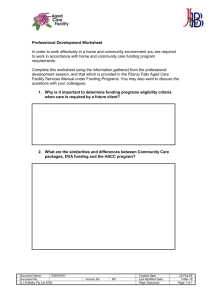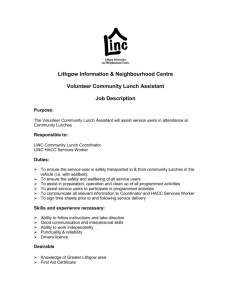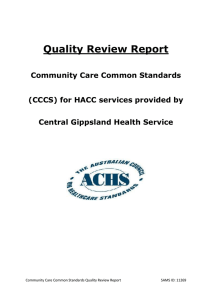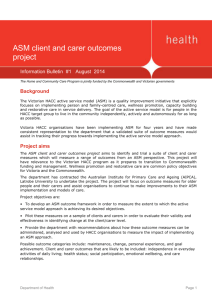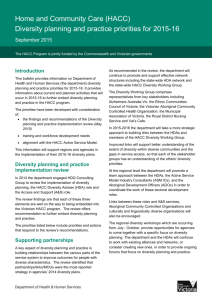Service coordination, assessment and care planning
advertisement
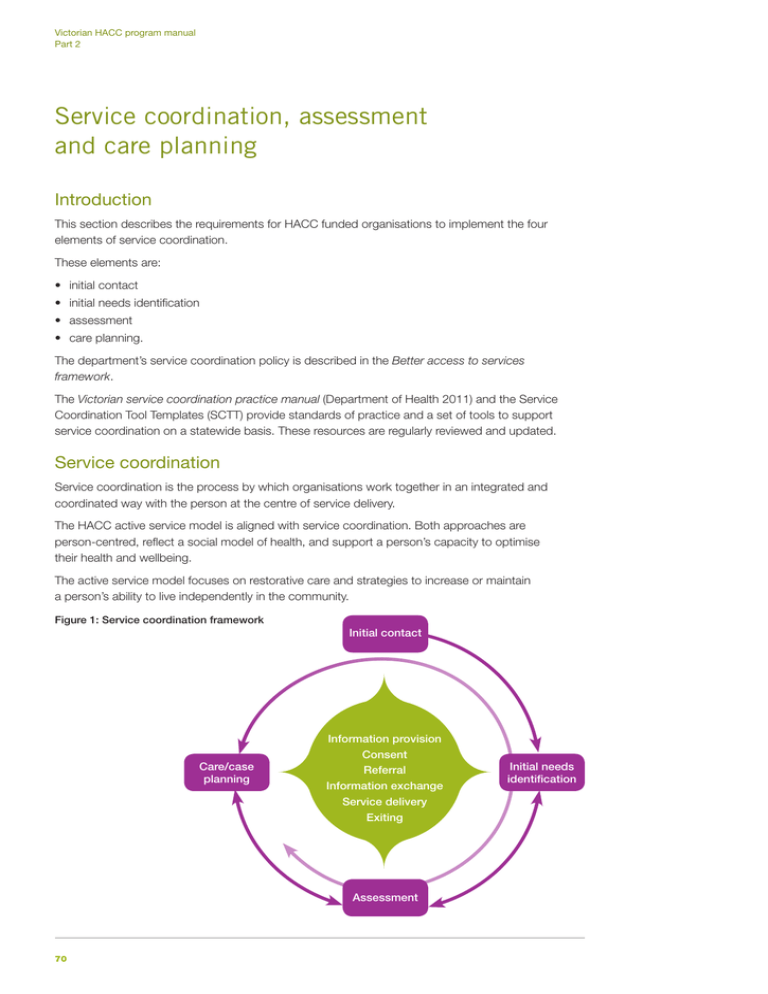
Victorian HACC program manual Part 2 Service coordination, assessment and care planning Introduction This section describes the requirements for HACC funded organisations to implement the four elements of service coordination. These elements are: • initial contact • initial needs identification • assessment • care planning. The department’s service coordination policy is described in the Better access to services framework. The Victorian service coordination practice manual (Department of Health 2011) and the Service Coordination Tool Templates (SCTT) provide standards of practice and a set of tools to support service coordination on a statewide basis. These resources are regularly reviewed and updated. Service coordination Service coordination is the process by which organisations work together in an integrated and coordinated way with the person at the centre of service delivery. The HACC active service model is aligned with service coordination. Both approaches are person-centred, reflect a social model of health, and support a person’s capacity to optimise their health and wellbeing. The active service model focuses on restorative care and strategies to increase or maintain a person’s ability to live independently in the community. Figure 1: Service coordination framework Initial contact Care/case planning Information provision Consent Referral Information exchange Service delivery Exiting Assessment 70 Initial needs identification Victorian HACC program manual Part 2 Initial contact and initial needs identification Initial contact is a person’s first contact with a HACC funded organisation, and in some instances the service system as a whole. During initial contact, basic client information is collected and information on service provision is provided. Initial needs identification (INI) is a broad screening process to identify: • whether a person is HACC eligible • the needs and issues that underlie the person’s needs • opportunities for early intervention, health promotion and improved health and wellbeing • level of priority. Depending on the person’s circumstances, INI covers broad areas of a person’s life including: activities of daily living; carer needs, living arrangements; accommodation, cultural needs; and personal safety. Information from the INI and the assessment process may result in referrals to other agencies if the person has broader needs that cannot be met by their organisation. Agencies need to comply with the new Vulnerable People in Emergencies Policy and should include screening for assistance with personal emergency planning in their INI processes. See section 4.18 of the Service agreement information kit for the Vulnerable People in Emergencies Policy. Assessment Assessment builds on the information collected at initial contact and initial needs identification. Assessment is an ongoing process of building a rapport with a person and their carer. Assessment begins at the first contact and continues through to service delivery, review and reassessment as circumstances change. A clear understanding of the different assessment pathways is important to ensure that: • people are assessed by the right person at the right time • people are assessed by staff with the appropriate expertise • assessments build on each other but do not duplicate • repetitive information gathering is minimised. Pathways for assessment in the HACC program are described in section 1.2 of the Framework for assessment in the HACC program in Victoria (Department of Human Services 2007). Service-specific assessments Service-specific assessments focus on the person’s needs for a particular type of HACC service. This includes clinical assessments for nursing and assessments for allied health interventions. All HACC clients will receive a service-specific assessment. The purpose of a service-specific assessment is to identify the person’s needs in relation to a particular area for example, meals support, respite, domestic assistance, personal care or social support. 71 Victorian HACC program manual Part 2 The outcome of a service-specific assessment is a care plan, sometimes called a service plan, which outlines the actions and interventions to be provided. While assessments will be based on presenting and underlying needs and will therefore vary for each person, they all build on the INI process and include: • the collection of information from the person and their carer about the person’s strengths, what they can do for themselves, activities that the carer carries out and areas where assistance is needed • a focus on the person’s goals and priorities and how the HACC service can assist in improving the person’s capacity to remain active and independent at home • the person’s diversity and cultural requirements relevant to the service to be provided, such as any personal care requirements • identification of occupational health and safety issues • risk management and fees assessment • practical information, for example in relation to the preferred hours of service delivery, transport and fees. Living at home assessment There are 99 designated HACC assessment services in Victoria. HACC assessment services comprise 73 local governments, 16 community health centres and health services, and 10 nursing and NGOs. The purpose of a Living at home assessment is to gain a broad understanding of the person’s needs for support, and their carer’s needs, in order to assist people to live at home as independently as possible. A Living at home assessment includes: • initial contact and initial needs identification • a holistic needs assessment with the person, carer and family members, usually in their own home, which focuses on: - opportunities for improving functional capacity and participation in social and community activities - risk management - identification of occupational health and safety issues • service-specific assessments for services provided by the assessing organisation (as required) including an occupational health and safety assessment (OHS) • goal directed care planning and service-specific care plans (as required) • care coordination for people receiving multiple services and/or services from multiple organisations. People can self-refer to a HACC assessment service or referrals can be made by carers, family members or other service providers including hospitals and general practitioners. Other HACC organisations should refer to their local HACC assessment service if they believe that a HACC-eligible person has broader needs that cannot be addressed through their organisation. 72 Victorian HACC program manual Part 2 For further information see: • Service agreement information kit for funded organisations: - section 4.13: ‘Language Services Policy’ - section 4.14: ‘Cultural diversity guide’. The ‘Cultural diversity guide’ includes the Victorian Government Aboriginal inclusion framework and Enabling choice for Aboriginal people with a disability. Care planning The purpose of care planning is to identify and design strategies to enhance a person’s capacity for independent living. Care planning should be guided by a person’s goals, interests and aspirations and involve family members and carers. It should build on the person’s strengths and capacities, and consider opportunities for health promotion. Care planning aims to ensure individuals can remain active and connected to their community during and after service provision. Care plans link the needs and problems identified at assessment to specific actions and interventions. A copy of the care plan should be provided to the person receiving care. For some people, the assessment process will result in a relatively simple care plan, while for others care plans will be more complex and involve multiple strategies, interventions and agencies. All HACC funded organisations should be working towards implementing goal directed care planning. Goal directed care plans detail: • needs and goals to be achieved • the nature of interventions or tasks to be performed by HACC-funded staff members as well as by the person themselves and/or carers and family members • referral to a HACC assessment service or other agencies if broader needs are identified • when and where HACC services will be provided • the fee structure • review dates and expected timeframe for service exit where applicable • the occupational health and safety (OHS) plan. Further information about assessment requirements of each HACC funded activity is contained in Part 3. Care coordination A subset of people with complex needs will receive services from multiple organisations and may require interagency care planning. In these circumstances a care coordinator is nominated to develop a shared support plan and facilitate service reviews in accordance with the care plan. 73 Victorian HACC program manual Part 2 A HACC provider may take on this role if: • the client needs an interagency response and does not have a care coordinator from another program area such as Hospital Admission Risk Program (HARP) • the HACC provider has the relevant expertise to carry out the care coordination role. Care coordinators liaise with the person and other participants in their care, such as general practitioners, to develop, monitor and review the shared care plan. The practices and standards described in the Victorian service coordination practice manual and the SCTT shared support plan should be used to support a coordinated approach. Service Coordination Tool Templates Service Coordination Tool Templates The Service Coordination Tool Templates (SCTT) is a suite of templates developed to facilitate and support service coordination practice. The SCTT is designed to record and share information as part of service coordination practice. Use of the SCTT assists service providers and practitioners to: • collect and share common consumer information • consider information across a broad range of health and wellbeing domains in accordance with the social model of health • record information in a uniform manner generated by initial contact, initial needs identification, assessment and care planning • record consumer consent to share information • make quality referrals and provide feedback • develop and share care plans • reduce the potential duplication of information and improve coordination if a person is receiving multiple services. Use of the SCTT The HACC program encourages the use of relevant SCTT tools as part of initial contact, initial needs identification and service coordination practice. The HACC program does not require every SCTT tool to be used for every client. Templates and profiles should be used as relevant to the person’s individual needs and circumstances. HACC funded organisations are required to use the relevant SCTT tools when making referrals to other HACC, health or community service organisations. SCTT 2009 was reviewed and updated in 2012. The SCTT 2012 tools are available on the Primary Care Partnership website in PDF and interactive word format. The SCTT user guide (2012) is also available online. The SCTT 2012 technical and functional specifications to support electronic data collection and referral are available to software vendors on the department’s Primary Care Partnerships website. Where organisations are using the SCTT in paper based form only they should be using the SCTT 2012 templates. 74 Victorian HACC program manual Part 2 SCTT 2009 SCTT 2009 contains four core templates, six optional profiles, the Care Coordination Plan and two supplementary templates. The minimum SCTT 2009 tools required for referral purposes are: • consumer information • summary and referral information • consumer consent to share information (retained by the sender) • living and caring arrangements. Depending on whether the HACC organisation makes referrals electronically or by paper (such as fax) the SCTT confidential referral cover sheet and acknowledgement may also be required. SCTT optional profiles are sent with a referral where relevant. HACC assessment services, Linkages, nursing and allied health services should complete and send the Functional assessment summary when making referrals in order to streamline assessment processes and reduce duplication. SCTT 2012 SCTT 2012 contains 15 templates. • Core templates: - referral cover sheet and acknowledgement - consumer information - summary and referral information - consent to share information. • Optional profiles: - single-page screener for health and social needs - need for assistance with activities of daily living - accommodation and safety arrangements - health and chronic conditions - social and emotional wellbeing - care relationship, family and social network - alcohol, smoking and substance involvement screening (ASSIST) - shared support plan. • Supplementary templates: - information exchange summary - functional assessment summary - palliative care supplementary information. 75 Victorian HACC program manual Part 2 Refer to the SCTT user guide (2012) for detailed information on each of these tools. The minimum SCTT 2012 tools required for referral purposes are: • referral cover sheet and acknowledgement • consumer information • summary and referral information • consumer consent to share information (retained by the sender) • accommodation and safety arrangements. Further guidelines about the use of SCTT 2012 by HACC funded agencies will be developed in 2013. The Functional Assessment Summary must be used as per SCTT 2009. Reporting requirements HACC funded organisations are required to participate in the Department of Health, Annual service coordination survey as distributed through the department and Primary Care Partnerships. Links The Victorian service coordination practice manual, SCTT user guide 2012 and suite of SCTT tool templates http://www.health.vic.gov.au/pcps/coordination/index.htm SCTT 2012 technical and functional specifications http://www.health.vic.gov.au/pcps/coordination/info_management.htm Framework for assessment in the HACC program in Victoria (Department of Human Services 2007) http://www.health.vic.gov.au/hacc/downloads/pdf/framework.pdf Strengthening assessment and care planning: a guide for HACC assessment services in Victoria (Department of Health 2010) http://www.health.vic.gov.au/hacc/downloads/pdf/assess_guide.pdf Strengthening assessment and care planning: dementia practice guidelines for HACC assessment services (Department of Health 2012) http://www.health.vic.gov.au/hacc/assessment.htm#download Goal Directed Care Planning Toolkit: Practical strategies to support effective goal setting and care planning with HACC clients http://www.iepcp.org.au/active-service-model-emr-hacc-alliance Carers Recognition Act (Victoria) 2012 and the Victorian Charter Supporting People in Care Relationships www.dhs.vic.gov.au/carersact Carer Recognition Act (Commonwealth) 2010 http://www.fahcsia.gov.au/sites/default/files/documents/07_2012/carer_recognition_act_0.pdf Vulnerable People in Emergencies Policy http://www.dhs.vic.gov.au/facs/bdb/fmu/service-agreement/contents HACC assessment services in each local government area (Department of Health 2013) http://www.health.vic.gov.au/hacc/downloads/pdf/assess_list_2013.pdf 76
